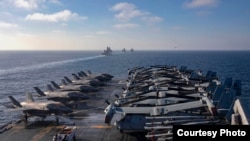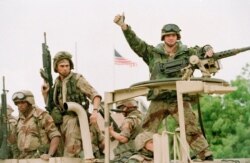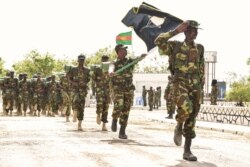The Pentagon has sent several naval vessels and a marine expeditionary unit to the coast of Somalia to support an operation repositioning hundreds of U.S. troops to bases elsewhere in East Africa.
The USS Makin Island Amphibious Ready Group and the 15th Marine Expeditionary Unit reached Somali waters on Monday. It joined the USS Hershel Woody Williams, an expeditionary sea base that arrived on December 16, according to the U.S. Africa Command (AFRICOM).
The vessels are supporting Operation Octave Quartz, with a mission to relocate U.S. forces in Somalia “while maintaining pressure on violent extremists and supporting partner forces,” the Pentagon said in a statement Tuesday.
In November, it was announced that U.S. President Donald Trump planned to draw down U.S. troops in Somalia, part of an effort to pull back forces globally — including in Afghanistan and Iraq — before he leaves office on January 20. The United States has approximately 700 military personnel in Somalia to train Somali troops and conduct counterterrorism missions.
The Pentagon has sought to reassure Somalis of its continued support in strengthening their forces and degrading the al-Shabab militant group.
The Makin Island Amphibious Ready Group consists of three vessels, including the amphibious assault ship of the same name. Combined with the expeditionary sea base USS Williams, they have nearly 5,000 troops to conduct maritime security operations.
The vessels have the combined “capability to boost firepower and protect and enable the repositioning of U.S. forces,” AFRICOM spokesperson Col. Christopher P. Karns told VOA Somali Service in an email Tuesday. “Also, if provoked, (they can) strike al-Shabab terrorists swiftly and with precision.
“For this operation, a full range of military capability is available to project power from sea, land or air,” he wrote. “… The ability to bring forth robust capability quickly should reassure partners. Also, al-Shabab should take notice and recognize what awaits those seeking to do harm. U.S. forces are clear-eyed and focused on completing this mission. U.S. Africa Command has an ability to bring forth added capability as situations warrant.”
Karns declined to provide details about AFRICOM’s strategy or timeline. But he insisted it would continue to develop Somali forces and conduct airstrikes against the militant group.
Concerns over drawdown
The U.S. troop drawdown in Somalia and its timing have sparked concerns.
“This decision couldn’t have come at a worse time. Its impact will directly affect the conduct of offensive operations,” said Samira Gaid, a national security expert in the Horn of Africa who was senior security adviser to former Somali Prime Minister Hassan Ali Khaire.
Even with the presence of U.S. forces and more than 20,000 African Union soldiers, al-Shabab militants have posed a persistent threat to Somalia and neighboring countries. On December 18 in the central Somalia town of Galkayo, a suicide bomber killed 21 people, including the commander of U.S.-trained forces in the town and his predecessor. That same day, militants abducted a local official in Kenya’s northeastern region bordering Somalia. His severed head was found Monday.
Gaid said she fears the drawdown will reduce support for the special forces unit known as Danab — the Somali word for “lightning” — which the U.S. military has been training and mentoring. The unit, established in 2013, now has roughly 1,100 troops.
She said the Danab have benefited from their U.S. mentors’ capabilities, whether in military intelligence, air surveillance or superior weaponry.
The presence of U.S. forces also has shielded Danab from being used to settle internal Somali political disputes, said another Somali official who was not authorized to speak to media and asked not to be named. The official suggested that with the drawdown, Danab members might be sent to address political disputes and would be vulnerable to al-Shabab attacks.
Building capacity
After its November announcement of the troop drawdown, AFRICOM resumed airstrikes to demonstrate its continued support.
A December 10 strike killed eight militants, the Pentagon said, noting it was the 50th U.S.-led strike in Somalia this year. Most target al-Shabab, but a few have been directed at pro-Islamic State terrorists.
U.S. airstrikes have killed roughly a thousand al-Shabab fighters since 2017, Karns said. The U.S. military carried out 35 strikes that year, 47 in 2018 and 63 in 2019, he said.
AFRICOM said its airstrikes disrupt al-Shabab activities and restrict the group’s movements and ability to expand.
The U.S. drawdown exposes Somalia’s unpreparedness to assume security responsibilities, analyst Gaid said, adding that its government must build a force capable of securing national land, air and sea borders and eliminating terrorist threats.
She offered an optimistic prediction: “If we double up the efforts and refocus, in 10 years, we can have that force.”
This story originated in VOA's Somali Service.













